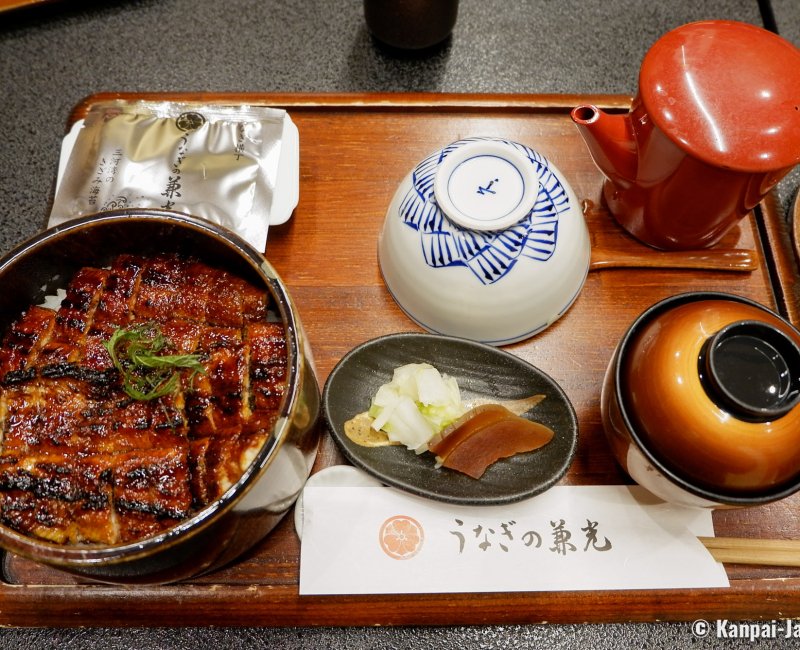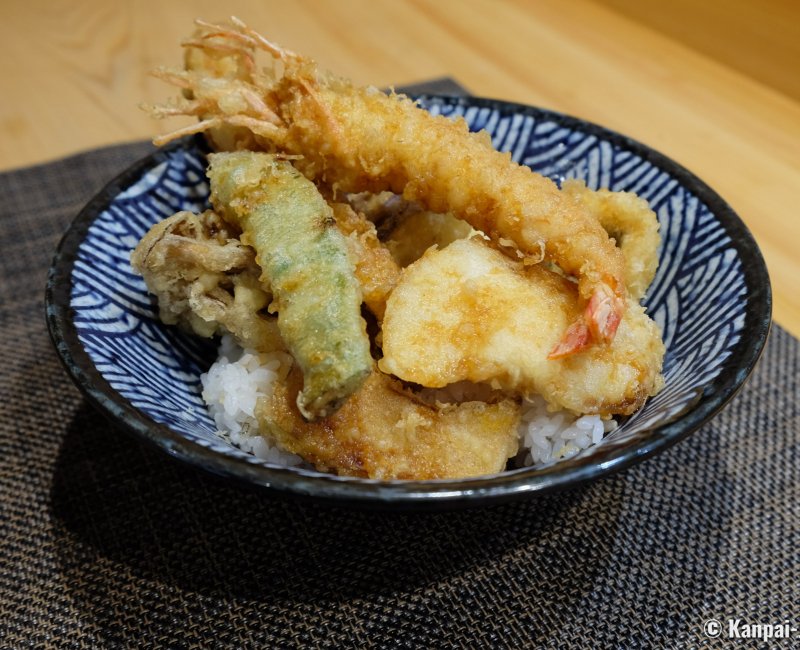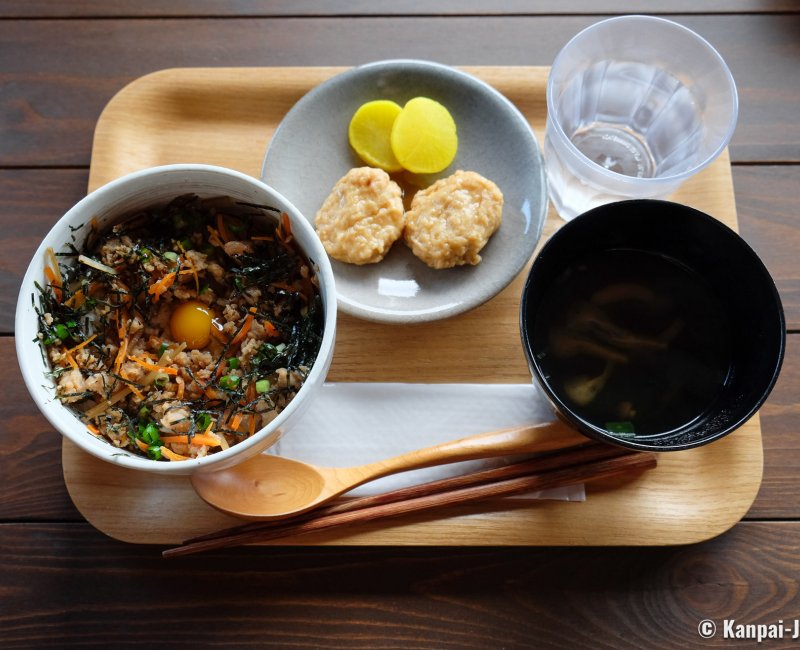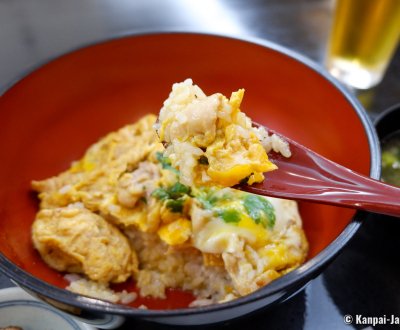Donburi
The Hearty Japanese Rice-Bowl Dish
Donburi is a Japanese rice-bowl dish topped with meat, fish or vegetables. This delicious, hearty and affordable meal is an every day comfort food with countless variations throughout the archipelago.
Every Japanese, regardless of age or social class, like their donburi (丼), or don for the shortened version, at least once a week. Both mouth-watering and retaining Japanese cuisine’s delicacy, this large bowl of rice is a real comfort food in Japan.
It is a very simple recipe made with good plain Japanese rice topped with delicious and varied ingredients: stir-fried beef, breaded pork, vegetables fritters or delicious raw fish slices. A donburi dish can therefore be served hot or cold, according to the topping ingredients.
In Japanese, there is a difference between:
- donburi-bachi (丼鉢), which means the actual bowl, the tableware; and,
- donburi-mono (丼物), that refers to the dish.
An invention of Buddhist monks
The origins of donburi date back to the Muromachi period (1336 - 1573) and to the vegetarian cuisine prepared in Buddhist temples in Japan. It was initially a dish called hôhan (芳飯), made of a bowl of rice and vegetables on which was poured a hot broth similar to a miso soup.
The donburi we know today was created much later, at the end of the Edo period (1603 – 1867) when trade with the feudal capital was thriving. A restaurant owner, wanting to keep hot the grilled eel skewers he cooked started to lay them down on a hot rice bowl and closed it with a lid. It was the first modern eel donburi. Delicious and easy to carry, this dish quickly became popular, especially among people fond of traditional theater, who could then attend performances that could be very long and still be able to enjoy a hot meal almost anytime.
The opening to the West during the Meiji era (1868 – 1912) introduced new eating habits, especially a larger meat consumption. The chicken or pork donburi appeared, and became a dish that workers could quickly eat for lunch. The raw fish rice-bowl is among the last of the newly created dishes, benefiting from the knowledge deepening of fresh fish products preservation.

The most popular donburi bowls
The same types of donburi are enjoyed throughout the archipelago. There are naturally regional variations but those are not as significant as in other Japanese dishes, such as the ramen 🍜 noodles, that have a nearly infinite number of variations.
Eel Unadon
The very first donburi recipe, the eel donburi, is called unadon (うな丼) and is without a doubt a must-try among the rice-bowl dishes. It is generously topped with eel fillets lacquered in the kabayaki style and grilled on a wood fire 🔥. The dish’s price is determined by the fish quality, and can vary from ¥1,500 (~US$9.55) to ¥5,000 (~US$31.85); which is quite expensive for a donburi. Narita’s historical city center has several restaurants specialized in unagi eel-based dishes.
Breaded pork Katsudon
In the katsudon (カツ丼), a breaded pork cutlet is sliced and wrapped in a thin omelet, sprinkled with onions and placed on the rice. Very hearty and delicious, this is the ideal donburi for big eaters.
Caramelized pork Butadon
The butadon (豚丼) has a plain rice layer covered with fine pork slices that were slightly caramelized in soy sauce (shoyu), and sometimes sprinkled with onion and a touch of ginger. This affordable meat dish ideally pairs with a very cool Japanese beer 🍺 in summer.
Beef Gyudon
A classic of the donburi cuisine, the gyudon (牛丼), is a rice bowl topped with beef meat that was minced and cooked in the sukiyaki style. The excellence of the dish and consequently its price vary according to the quality of the meat, that can even extend to Wagyu tender beef. Gyudon is commonly served in Japanese fast-food chains such as Yoshinoya, Matsuya or Sukiya for the most widespread.
Chicken and egg Oyakodon
Oyakodon (親子丼) is made of rice and bite size chunks of chicken fillet that was stir-fried in a pan with onions, flavors and beaten eggs to get a runny omelet. A real comfort food, enjoyed by the youngest, its name literally means the "children and parents' donburi," the children being the eggs and the parents the chicken.

Tempura fritter Tendon
Tendon (天丼) is a donburi topped with tempura fritters of seafood and vegetables. The fritters are often made with shrimps, squids, eggplants, green beans, mushrooms, shiso leaves, and according to the seasons, slices of pumpkin or sweet potato 🍠.
This dish is usually on the menu of tempura or Japanese noodles (soba and udon) restaurants. Its prices varies on average from ¥1,000(~US$6.37) to ¥3,000 (~US$19.11) depending on the restaurant’s reputation, the quantity and quality of the ingredients used. To enjoy a delicious and affordable tendon, it is best is to go in countryside towns and smaller fishing ports, that usually have very good restaurants. In Tokyo, the fast-food chain Tendon Tenya is worth the try.
Sashimi topped Kaisendon
Kaisendon (海鮮丼) is a rice-bowl topped with various raw fish sashimi. The most commonly used fish are salmon, tuna, yellowtail, mackerel, shrimp and sometimes completed with a tuna puree seasoned with ginger and wasabi. People who love sushi 🍣 are strongly recommended this varied and quite affordable dish. The restaurant chain don-maru (丼丸) sells small kaisendon from ¥500 (~US$3.18), with a good value for money.
Visually appealing and mouthwatering with all its varied colors and textures, the general rul to eat kaisendon is to starts with the fish and seafood with the lighter taste, namely those with a white flesh. The raw fish is seasoned with soy sauce, which is either directly poured on the bowl or put in a side dish for dipping the fish slices.
Tuna Maguro-don
A spin on the kaisendon, the maguro-don (まぐろ丼) has only one type of fish, namely maguro tuna, that can also vary according to its type of slice and amount of fat. The rice is covered with akami tuna slices, with a darker shade of red, to the light pink and smoother otoro sashimi slices.
When the raw tuna is marinated, for example in soy sauce and mirin, the donburi is called maguro-zuke-don (まぐろ漬け丼).
Fish eggs Ikura-don
In the same genre, the ikura-don (いくら丼) is rice covered with fish eggs, especially salmon or mackerel eggs, the most consumed in Japan. This dish is often served very fresh in restaurants of coastal towns, near a local fishing port.
Chukadon, of Chinese inspiration
Chukadon (中華丼) is drawing its inspiration from Chinese cuisine, and the rice is topped with various stir-fired vegetables (cabbage, bamboo sprouts, mushrooms and onions), garnished with meat and small shrimps.
In Tokyo’s restaurants, you’ll find more international variations of the donburi, as new adaptations are still ongoing. For example, you can try a foie-gras-don with a thick seared slice of foie gras topping the rice, or a hearty kebab-don.

A unique one-dish meal in a set
You can find ready-to-eat garnished rice-bowls everywhere in Japan: as bento 🍱 in a konbini, in supermarkets, to take away in specialized shops or on the menu of fast-food chains or traditional restaurants.
Prices start on average at ¥500 (~US$3.18) for a classic bowl topped with meat, of a standard size. Fish donburi are more expensive, with prices starting from ¥1,000 (~US$6.37).
A donburi served in a restaurant often comes in a menu, sided with a small miso soup and a few tsukemono pickles. Balanced and hearty, it is self-sufficient and easy to eat with a spoon. It is sometimes possible to choose the rice quantity, using the following words to indicate the portion size:
- shou (小) or sukuname (少なめ) for a small serving;
- nami (並), futsû (普通) or chû (中) for a standard serving;
- dai (大), ômori (大盛り) or ôme (多め) for a large serving; and,
- tokumori (特盛) or tokudai (特大) for a very large serving.
The standard serving is usually enough, even for a traveler who would walk a lot on a sightseeing day.
Easy to prepare, the donburi is also often cooked at home, using the stir fried meat and vegetable leftovers as a topping on the rice. It is also easily available outside Japan as its base ingredients such as Japanese rice and the sauces used to flavor the toppings, like shoyu, mirin or dashi are usually available at food stores’ Asian aisles. You can even create your own recipe to try recall the flavors of Japan.
Vocabulary

